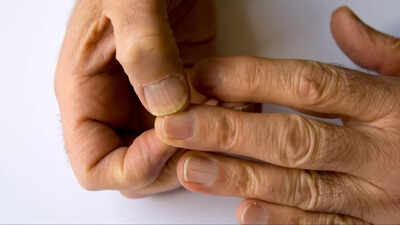ARTICLE AD BOX

7 types of changes in nails and why they should be very closely monitored (Image: iStock)
Your nails are more than just for beauty, they are tiny health reporters. Studies show that changes in nails can reveal anaemia, infections, heart or lung problems and even cancer.
Changes in fingernails are often dismissed as cosmetic but nails frequently mirror systemic health. While some alterations are harmless, others are early warning signs of serious disease like cardiopulmonary problems, systemic illness, infection or cancer. Nail examination is a quick, non-invasive window into general health. Academic and clinical reviews repeatedly show that a careful nail exam can reveal anaemia, chronic lung or heart disease, hepatic dysfunction, systemic infection and even early melanoma.
These are conditions where early detection changes outcomes. Watch out for the following seven nail changes that you should closely monitor. If you notice any of these seven changes, especially if they are new or unexplained, don’t brush them off. A quick doctor visit can sometimes catch problems early and even save lives.
Beau’s lines: Grooves across the nail
These are horizontal dents or lines running across the nail. They usually appear when the body goes through a major stress like a high fever, surgery or a serious illness. If you see these and don’t recall a recent illness, check with your doctor. A 2017 study published in QJM: An International Journal of Medicine explained that “Beau’s lines indicate temporary nail growth arrest after systemic stress.”
Spoon nails (Koilonychia): Nails curving upward
These are thin nails that look scooped out, almost like a spoon. This is often linked to iron deficiency anaemia. A simple blood test can confirm anaemia so don’t ignore this sign. According to a 2023 study in StatPearls, Koilonychia may signal iron-deficiency anaemia or systemic disease.
Yellow, thick nails: Yellow Nail Syndrome
Do your nails grow slowly and look yellow and thick? Sometimes it is just fungal infection but when it comes with swelling in the legs or breathing problems, it may be Yellow Nail Syndrome. If yellow nails come with cough, swelling or breathing trouble, see a doctor quickly. A 2017 review in Orphanet Journal of Rare Diseases described it as “yellow nails accompanied by lymphedema and respiratory disease.”
Crumbly or thick nails: Fungal infection
When nails are thick, crumbly or discoloured (yellow, brown or white), it is often caused by a fungus, called onychomycosis and it is common in toenails. Fungal infections don’t heal on their own so get tested and treated.Researchers in the 2020 review of the Journal of Fungi noted that untreated fungal nails “can cause pain, secondary infection and decreased mobility.”
Thin red-brown lines: Splinter haemorrhages
These are tiny red or brown lines under the nails, like splinters. Small trauma is common but multiple lines may point to heart infection (endocarditis) or blood vessel disease. If you have these with fever or fatigue, get checked immediately. A 2022 review in the International Journal of Dermatology explained that splinter haemorrhages can reflect systemic disease including infective endocarditis or vasculitis.
Dark stripe down the nail: Could be Melanoma
It is a brown or black stripe running lengthwise. Sometimes it is harmless but in adults, a new stripe can mean skin cancer under the nail (subungual melanoma). In case of a new dark stripe, see a dermatologist urgently. A 2014 review in the Journal of the European Academy of Dermatology and Venereology warned that misdiagnosis delays life-saving care.
Clubbing or white nails: Possible lung or liver issues
This is when the fingers look bulbous and nails curve down (clubbing). Sometimes nails look white with a small pink band at the tip (Terry’s nails). Clubbing can signal lung or heart disease while Terry’s nails are linked to liver disease. New clubbing or white nails are serious red flags so don’t ignore them. A 2017 review in Clinics in Liver Disease linked Terry’s nails with cirrhosis while a 2022 study in StatPearls shared that clubbing is most often associated with pulmonary or cardiovascular disease.Regular self-checks and prompt professional assessment, when you notice the seven changes above, can lead to timely diagnosis and treatment.



.png)
.png)
.png)
















 1 hour ago
4
1 hour ago
4








 English (US) ·
English (US) ·